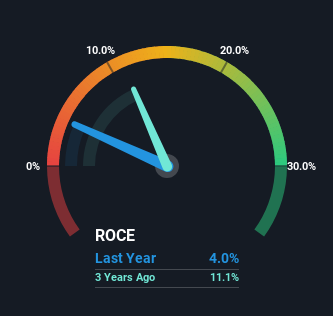- India
- /
- Consumer Durables
- /
- NSEI:WHIRLPOOL
Be Wary Of Whirlpool of India (NSE:WHIRLPOOL) And Its Returns On Capital

To find a multi-bagger stock, what are the underlying trends we should look for in a business? Firstly, we'll want to see a proven return on capital employed (ROCE) that is increasing, and secondly, an expanding base of capital employed. If you see this, it typically means it's a company with a great business model and plenty of profitable reinvestment opportunities. Although, when we looked at Whirlpool of India (NSE:WHIRLPOOL), it didn't seem to tick all of these boxes.
What Is Return On Capital Employed (ROCE)?
If you haven't worked with ROCE before, it measures the 'return' (pre-tax profit) a company generates from capital employed in its business. To calculate this metric for Whirlpool of India, this is the formula:
Return on Capital Employed = Earnings Before Interest and Tax (EBIT) ÷ (Total Assets - Current Liabilities)
0.04 = ₹1.7b ÷ (₹55b - ₹14b) (Based on the trailing twelve months to September 2023).
Thus, Whirlpool of India has an ROCE of 4.0%. Ultimately, that's a low return and it under-performs the Consumer Durables industry average of 14%.
See our latest analysis for Whirlpool of India

In the above chart we have measured Whirlpool of India's prior ROCE against its prior performance, but the future is arguably more important. If you'd like, you can check out the forecasts from the analysts covering Whirlpool of India here for free.
What Can We Tell From Whirlpool of India's ROCE Trend?
When we looked at the ROCE trend at Whirlpool of India, we didn't gain much confidence. Around five years ago the returns on capital were 23%, but since then they've fallen to 4.0%. However it looks like Whirlpool of India might be reinvesting for long term growth because while capital employed has increased, the company's sales haven't changed much in the last 12 months. It may take some time before the company starts to see any change in earnings from these investments.
On a side note, Whirlpool of India has done well to pay down its current liabilities to 25% of total assets. That could partly explain why the ROCE has dropped. Effectively this means their suppliers or short-term creditors are funding less of the business, which reduces some elements of risk. Some would claim this reduces the business' efficiency at generating ROCE since it is now funding more of the operations with its own money.
The Key Takeaway
To conclude, we've found that Whirlpool of India is reinvesting in the business, but returns have been falling. And with the stock having returned a mere 9.6% in the last five years to shareholders, you could argue that they're aware of these lackluster trends. Therefore, if you're looking for a multi-bagger, we'd propose looking at other options.
On a final note, we've found 1 warning sign for Whirlpool of India that we think you should be aware of.
While Whirlpool of India may not currently earn the highest returns, we've compiled a list of companies that currently earn more than 25% return on equity. Check out this free list here.
Valuation is complex, but we're here to simplify it.
Discover if Whirlpool of India might be undervalued or overvalued with our detailed analysis, featuring fair value estimates, potential risks, dividends, insider trades, and its financial condition.
Access Free AnalysisHave feedback on this article? Concerned about the content? Get in touch with us directly. Alternatively, email editorial-team (at) simplywallst.com.
This article by Simply Wall St is general in nature. We provide commentary based on historical data and analyst forecasts only using an unbiased methodology and our articles are not intended to be financial advice. It does not constitute a recommendation to buy or sell any stock, and does not take account of your objectives, or your financial situation. We aim to bring you long-term focused analysis driven by fundamental data. Note that our analysis may not factor in the latest price-sensitive company announcements or qualitative material. Simply Wall St has no position in any stocks mentioned.
About NSEI:WHIRLPOOL
Whirlpool of India
Manufactures and markets home appliances in India and internationally.
Flawless balance sheet with proven track record.
Market Insights
Community Narratives



